Table of Contents
We probably don’t have to explain in detail what a snack is. It is usually a meal that we consume between main meals, i.e. between breakfast and lunch or between lunch and dinner. Sometimes, however, we can consider a snack to be, for example, something we bite on while watching an evening show on TV, when our hands keep reaching for potato chips, sweet bars or popcorn without thinking.
Our parents were convincing us about the importance of snacks since we were small children, when they prepared smaller or larger snacks for us to take to school, which we then exchanged with our classmates according to our taste. Some of us have carried out regular snacks between meals into adulthood, others can do with three larger main courses. If you are part of a snack team, you can find inspiration in today’s article on what an ideal snack should look like and how you can replace less appropriate snacks with healthier alternatives. If, on the other hand, you avoid snacking, believe us, after reading our tips, once in a while you will enjoy some goodies between meals.
How big should a snack be?
In terms of size, your snacks can vary greatly based on what ingredients they are made of. However, to get some basic idea, we will start with our caloric intake. Here are two model examples:
- Miss Jane, who is 170 cm tall, weighs 60 kg and is 20 years old.
- Mr David, who is 180 cm tall, weighs 80 kg and is 30 years old.
We can consider both of them as slightly active individuals who do sports 1-3 times a week. We enter this data into our online BMR calculator, where we find that the recommended caloric intake for Jane is 1927 kcal and for David 2448 kcal.
It is important to take into account other nutritional recommendations, according to which protein intake should be between 0.8-2 g protein per kg of body weight, carbohydrates should make up 40-65% and fat 20-30% of daily caloric intake. In our model examples, we will stick to the gold standard values, so we will count with 20% of protein intake, 55% of carbohydrate intake and the rest of the caloric intake (25%) will be covered by fats. [1] [8] [9]
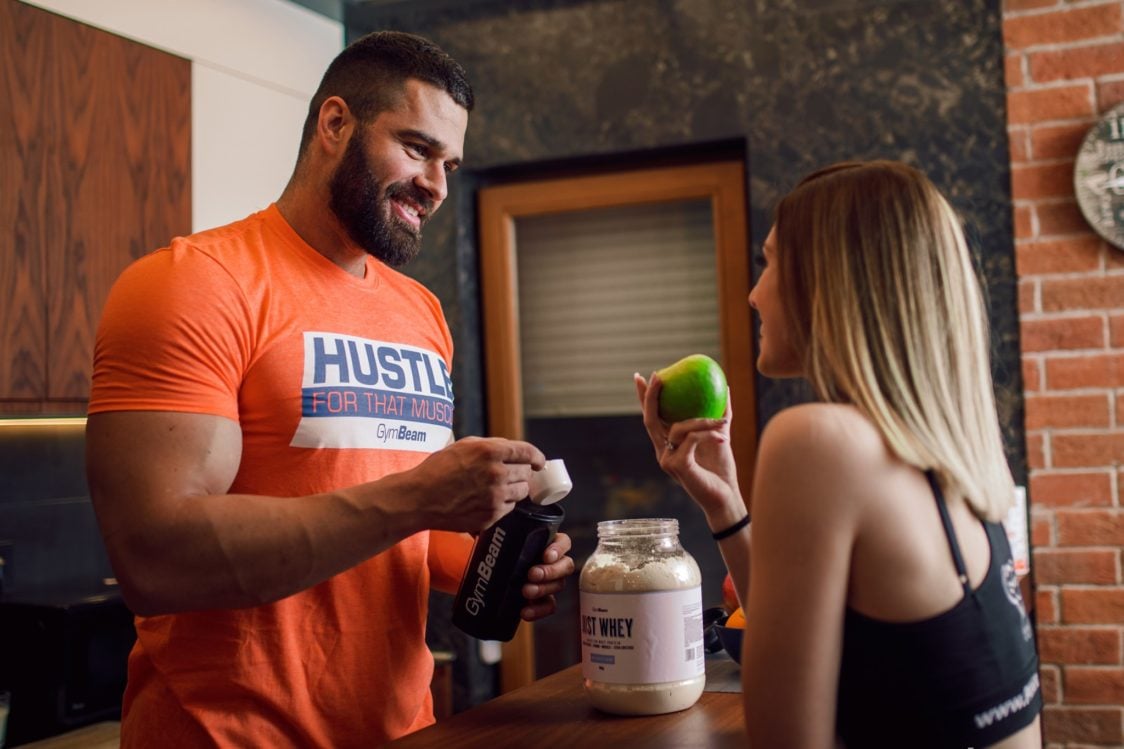
At the same time, it is necessary to divide the daily intake as a percentage into individual courses. As a general rule, breakfast should account for approximately 20% of daily intake, lunch 35% and dinner 30%. We will then have approximately 15% of our daily intake left for snacks. In our model example, Jane and David will complete this 15% with one snack. What should the optimal ratio of macronutrients in a snack look like? [2] [8] [9]
- Jane’s snack should be approximately: 289 kcal, 40 g of carbohydrates, 15 g of protein, 8 g of fat.
- David’s snack should be approximately: 367 kcal, 50 g of carbohydrates, 18 g of protein, 10 g of fat.
What could Jane’s and David’s snack look like in real life?
| Snack | Portion for Jane | Portion for David |
|---|---|---|
| Skyr (0,1 % of fat), apple, oatmeal, walnuts | Skyr 80 g, apple 100 g, oatmeal 30 g, walnuts 10 g | Skyr 80 g, apple 150 g, oatmeal 40 g, walnuts 12 g |
| Wholemeal bread, cream cheese, ham, eggs, pepper | Bread 50 g, cream cheese 15 g, ham 10 g, small egg 55 g, pepper 100 g | Bread 65 g, cream cheese 15 g, ham 20 g, small egg 55 g, pepper 150 g |
| Cottage, tomato, rice crackers, cashew nuts | Cottage 100 g, tomato 100 g, rice crackers 30 g, cashew nuts 5 g | Cottage 130 g, tomato 100 g, rice crackers 45 g, cashew nuts 5 g |
| Smoothie from soya milk, vegan protein, banana, peanut butter | Soya milk 150 g, vegan protein 10 g, banana 130 g, peanut butter 10 g | Soya milk 200 g, vegan protein 15 g, banana 160 g, peanut butter 13 g |
In the table above we can see what an ideal snack could look like for a woman and man in case if they wanted to stick to the optimal distribution of nutrients. However, it is also important to mention the individual needs of each person. Some people like to eat more carbohydrates in the morning and others in the evening. Likewise, the need for proteins and, in general, their caloric intake varies from person to person, according to which it is then necessary to adjust the portion size and the ratio of individual macronutrients.
However, it is optimal that each snack contains all three macronutrients – i.e. proteins, carbohydrates and fats. However, it is not as complicated as it might seem at first glance. All you have to do is take, for example, bread (a source of carbohydrates), eggs and cheese (sources of protein and fat) and add some vegetables for perfection. Simple, right? We can apply the same for sweet foods. Yogurt as a source of protein, oatmeal and fruit as a source of carbohydrates and peanut butter as a source of fat. This way we can combine every snack, just think about it a little.
You might be interested in these products:
What to do if everything doesn’t go according to plan
Even though we know what an ideal snack, which contains all macronutrients in an optimal ratio, should look like, let’s face the fact that ordinary hectic days are far from ideal. Sometimes we are glad that we even manage to get some lunch at all, and we do not even think about snacks, other times we are chased by sweet tooth all day, so it is nice to have some snack on hand, which does not increase our daily energy intake too much. Let’s take a look a few examples of what we can snack on when we are in a rush and need to eat something in a hurry. We will also show you how to drive away the evening munchies in front of the TV or the afternoon snacking with your coffee.
Quickies when you are in a hurry
If you are in a rush, and you’re hungry, you don’t have to worry so much that the snack won’t have the ideal nutrient ratio, and for example, contains only a small amount of protein, but only in case if you supplement it in your next meal. At a time like this, it’s good to have a healthier snack on hand that will fill you up at least a little, so that you don’t come home and clear out the fridge. What can you always have on hand?
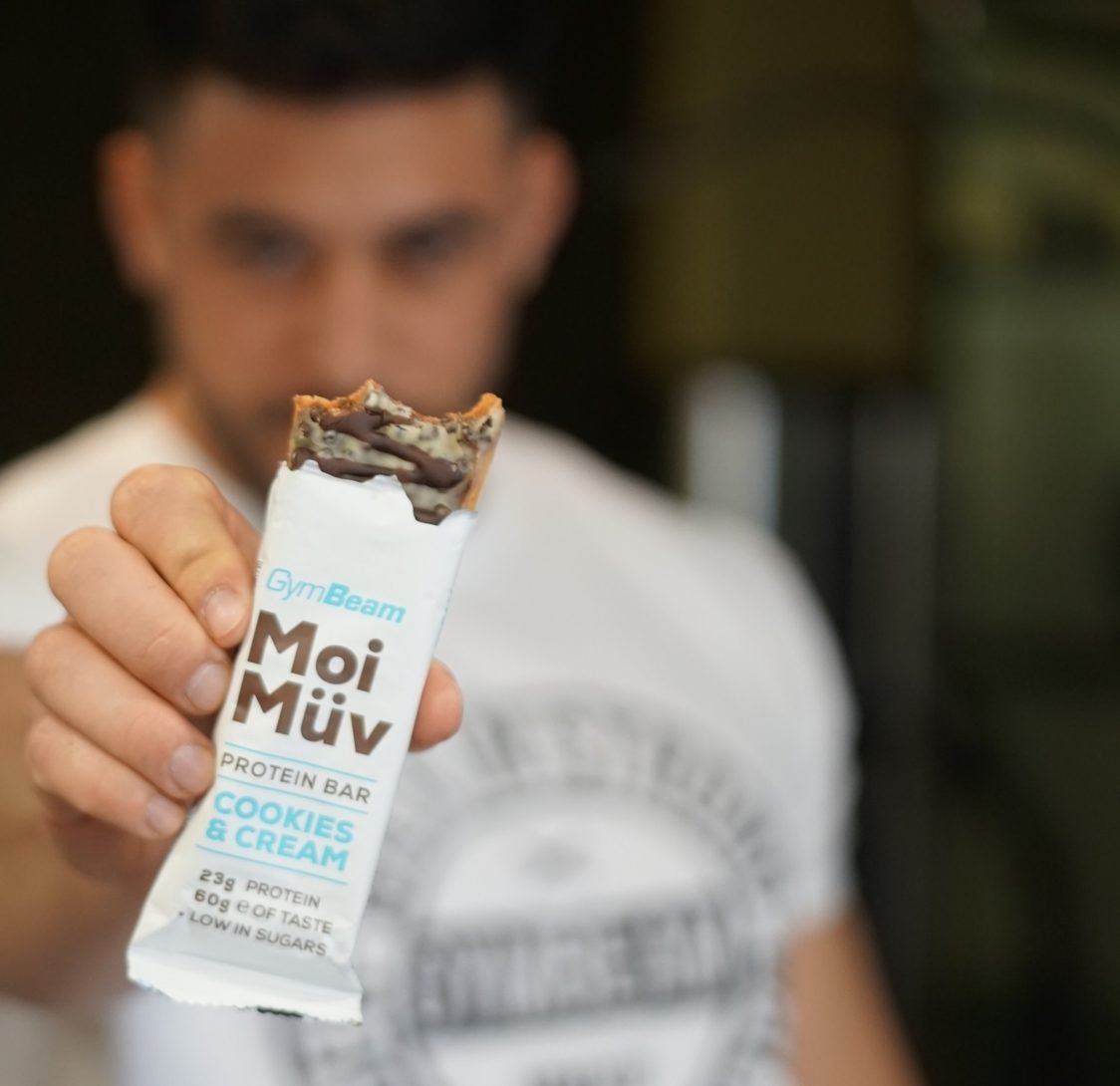
1. A bar or a cookie
Having some bar in your purse, backpack or work bag is never a bad idea. If you want the bar to fill you up, and you know that you have a problem eating the required amount of protein during the day, a protein cookie or a protein bar may be a suitable option for you. And if you prefer some classic chocolate bar, for example a Mars bar, you may want to try its healthy protein version.
For those who do not have a problem with protein intake and expect a quick energy replenishment from the snack, there are energy bars or flapjacks. Most pre-packaged bars or biscuits have the advantage that nothing bad happens if you have them in your bag for a few weeks before you eat them. After a while, however, you risk snacking the biscuit crumbs instead of a delicious bar.
2. Fruits and vegetables
However, we cannot talk about long shelf life with fresh vegetables or fruits. If you carry, for example, a banana in your purse for a month, it will probably go straight to the bin, and maybe the purse too. However, this is definitely not a reason to reject these types of food. These are great sources of micronutrients, which usually do not have as many calories as processed bars.

If you are watching your weight, a large apple (175 g), which has 100 kcal, will definitely be more suitable for you as a quick snack than a 100 g flapjack, which has 400 kcal. Hard fruits, such as an apple or a pear, are ideal to carry around. Alternatively, you can also carry small fruits (raspberries or blueberries) in empty peanut butter jars. We also have a great tip for people who search for fruit with a long shelf life, which they can take anywhere.
Lyophilized fruit will do a perfect job in this case. However, you must keep an eye on the amount of it. For example, lyophilized strawberries have approximately eight times more calories than the same amount of fresh strawberries. However, if you have 50 g as a snack, your daily intake will definitely not increase significantly, and on the contrary, you will supply the body with the necessary nutrients.
For comparison:
- 100 g of fresh strawberries has 35 kcal
- 100 g of lyophilized strawberries has 286 kcal
And the vegetables are even better in calories. If you had a richer lunch, a sliced cucumber or carrot may be enough for you as a quick snack. Thanks to the fiber content, you will support the feeling of satiety by eating vegetables, and in addition to that, it should prevent you from wandering around the kitchen at work and looking for something to snack on. All you have to do is prepare a box in advance, into which you can pre-cut any kind of vegetables.
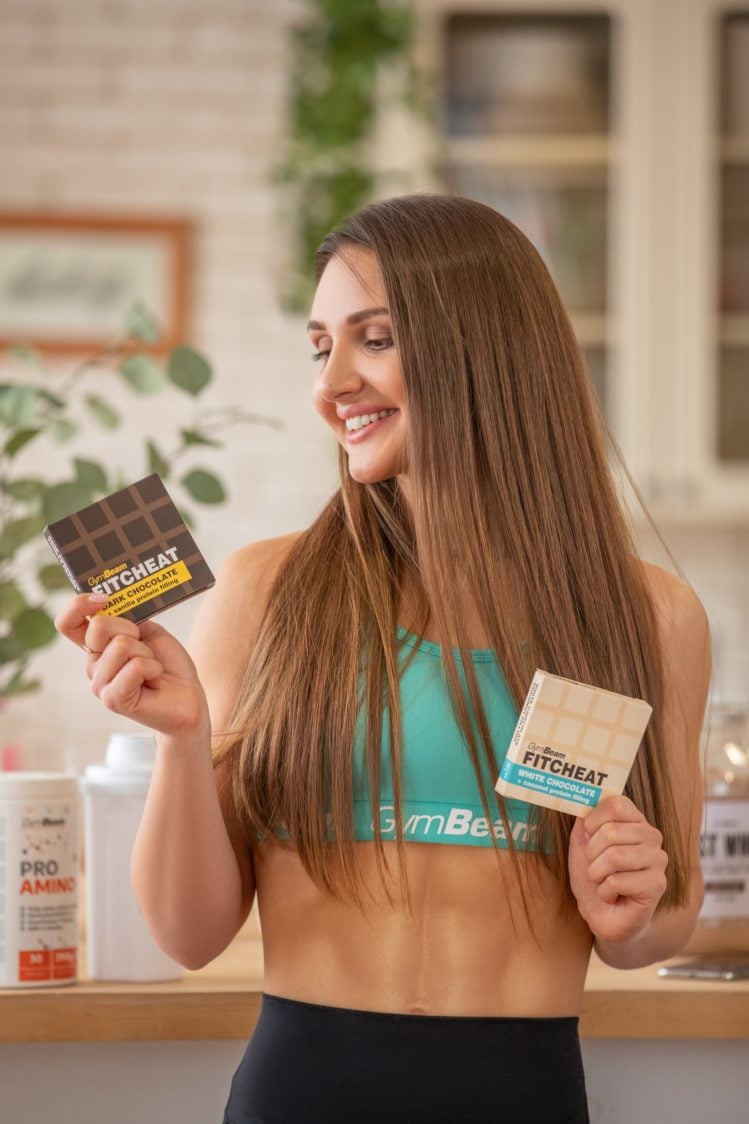
3. Chocolate
Of course, in the case of chocolate, we probably can’t call it a balanced snack. However, it is definitely not a bad idea to have a piece (approx. 20 g) of chocolate with high cocoa content hidden in your bag or desk. All you have to do is cut the whole bar into smaller pieces and individually wrap them in foil. Thanks to this, you will have your daily portion clearly determined. Also, you don’t have to worry about a cheat meal like this. According to studies, chocolate is rich in iron, magnesium, copper and manganese.
In addition, it has a positive effect on lowering blood pressure and overall blood circulation. High-percentage chocolate also has the advantage that even a small piece will be enough to drive away the cravings. So you probably won’t eat the whole bar, which could easily happen to you with sweet milk chocolate, for example. Even with regard to the benefits, chocolate with high cocoa content will be a better choice. [3] [4]
However, we also have an alternative for those who do not like high-percentage chocolate for any reason and simply do not want to restrain from their beloved white chocolate. The ideal solution may be Fitcheat protein chocolate with a reduced sugar content and a higher proportion of protein, which, however, certainly does not taste worse. Maybe just the opposite. It’s up to you to decide whether to try white chocolate with coconut or white chocolate with strawberries as your first try.
4. Nuts
Another type of food that you can carry in your bag for a long time without worrying about expiration date are nuts. It is not necessary to have the whole bag with you, all you have to do is pour a handful into a bag, which will serve as an “emergency snack”. According to studies, nuts have a positive effect on cholesterol levels, and in addition can reduce the body’s inflammation. But watch out for the amount, the calories from the nuts jump faster than you would like. [5] [6]
5. Savoury protein munching
With this tip, we will please all lovers of savoury goodies, who are not too excited by the idea of chocolate, but when they think of salted potato chips, they start to feel hungry. If these cravings catch up with you during the day, protein chips can be a great solution, as they have a higher protein content and are also packaged in smaller quantities, so that even eating the whole bag can be considered a healthier version of a snack.
You can also drive away the salt cravings with dried meat. One 50-gram pack will supply your body with 32 g of protein, so this snack can be ideal for anyone who has a problem with sufficient protein intake. And if you add vegetables from the lunch box you prepared in advance, it will be even better.

6. Liquid snack
When we talk about liquid form of quick snack, we definitely don’t mean to have a beer and get back to your work. During a hectic day, there may be times when your stomach starts to growl, but you are in a situation where it is not appropriate to eat (meeting, school lecture), so it is good to have “liquid calories” on hand that will fill you up and stop you from starving to death. For such cases, you can have one portion of protein, which you just need to mix with some water or meal replacement shake that will supply your body not only with protein, but also other macronutrients.
You can also enjoy an unflavoured kefir drink, but it must be stored in the cold so that it doesn’t go bad. And MoiMüv Protein Milkshake could also do a great service, as it excels in its high protein content, low fat content and absence of added sugars. The big advantage is that you don’t have to store it in the fridge before opening it, so you can have it on hand at any time during the day.
Evening snacks and food for guests
I suppose everyone has ever experienced the feeling of having eaten all the planned meals for the day, but in the evening started thinking about having an extra snack. Fortunately, even for these cases, there are healthier, more suitable and also less caloric alternatives to night-time nibbling while watching a TV. You can also use these tips for snacks when hosting visitors. You will see that everyone will enjoy them and often they might not even recognize that these are less caloric versions.

1. Tortilla “nachos”
If you are a lover of this Mexican delicacy, where you dip your crispy pieces recklessly in a mayonnaise or dense cheese dip, you might like this healthier version, which everyone can prepare at home. All you have to do is cut the tortilla into pieces, spray it with oil, sprinkle with your favourite spices and bake in the oven until crispy. You can use homemade or store-bought tomato salsa as a dip or even guacamole, which you can easily prepare from avocado and tomatoes at home. And if you follow a really strict diet, you can also use calorie-free sauce.
How many calories will a healthier option save us?
- 100 g nachos (470 kcal) and 50 g cheese dip (102 kcal) = 572 kcal
- 100 g tortilla nachos (290 kcal) and 50 g guacamole (53 kcal) = 343 kcal
If you opt for a healthier alternative, you will save approximately 229 kcal which is an amount that corresponds to about two servings.

2. Healthier fries
French fries are simply a classic that people all over the world love. The raw ingredient from which they are prepared, usually potatoes, is fine. However, the fact that the French fries, for example in fast food chains, are fried in a fryer, fundamentally adds to their fat content and the resulting caloric value.
If you want to enjoy French fries, make them at home in the oven, so you know what they are made of. To make it more interesting, you can also cut the fries from sweet potatoes or other vegetables (celery, carrots, etc.), whatever you use is up to you. The resulting caloric value also depends on the dip you choose. Instead of mayonnaise or tartar sauce, choose ketchup, yoghurt dip, calorie-free ketchup or, for example, calorie-free Caesar dressing.
How many calories will a healthier option save us?
- 100 g French fries (275 kcal), 30 g mayonnaise (201 kcal) = 476 kcal
- 100 g baked celery chips (64 kcal), 30 g ketchup sweetened with xylitol (21 kcal) = 85 kcal
- 100 g potato wedges (119 kcal), 30 g yogurt dip (20 kcal) = 139 kcal
By having a portion of celery chips, you can save approximately 391 kcal compared to classic fried potatoes. If you prepare potato wedges with yogurt dip at home, you will save 337 kcal compared to fast food fries.
3. Vegetable Canapés
Whatever the occasion, canapés is a must part of a buffet. Although such small pieces of food seem to have virtually no calories, the opposite is true. Luckily, we also have a tip for a healthier option for this delicacy. How about exchanging the baguette for vegetables – for example, cucumbers, which have a similar shape, and exchange a spread full of mayonnaise, for a cottage cheese spread? It is also not necessary to add any sausages. For a canapé, you can use either a piece of vegetable or a slice of ham.
How many calories will a healthier option save us?
- 40 g baguette (121 kcal), 50 g garlic mayonnaise spread (168 kcal), 40 g sausage (113 kcal) = 402 kcal
- 100 g cucumber (14 kcal), 50 g cheese-based garlic spread (55 kcal), 40 g chicken ham (39 kcal) = 108 kcal
A healthier version of canapés has 294 less kcal which is an amount that corresponds to about one serving.
4. Healthy crunching
If you are a lover of savoury snacks, we most likely don’t have to introduce you to cheese puffs. However, their ingredients are definitely not as healthy for you to enjoy them every day without remorse. However, this does not apply to their healthier version, which you can make at home from chickpeas. They are really easy to prepare and the result is worth it. All you have to do is cook the chickpeas in advance (you can also buy a can of chickpeas in brine, which will make your work easier), add a teaspoon of oil, salt, your favourite spices and bake them in the oven until golden brown.
How many calories will a healthier option save us?
- 100 g cheese puffs (519 kcal)
- 100 g baked chickpeas (150 kcal)
A healthier version of this snack has approximately 369 less kcal.
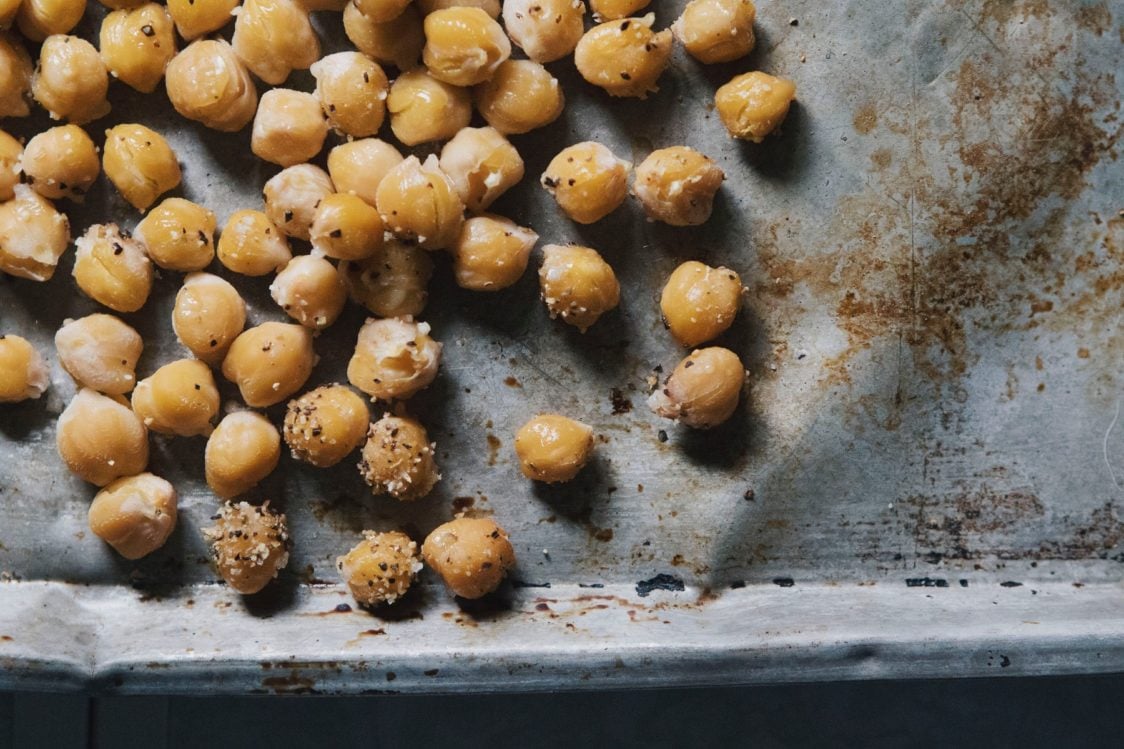
5. Hummus with vegetables
Hummus is another way of how you can use chickpeas. Again, it’s up to you whether you cook it yourself at home or use it store-bought version in brine. The basis of the hummus is, in addition to the mentioned chickpeas, tahini paste, lemon juice, olive oil, garlic and other spices. The resulting caloric value will depend on the ratio of each raw material you choose. You can spread it on pastry or dip pieces of vegetables in it. In both cases, it tastes great and can be used as a snack or food for your guests.
How to make a healthier sweet treat with your coffee?
1. Choose more suitable alternatives to processed foods
Again, we return to what has already been said in the section on quick snacks when you are in a hurry. Nowadays, there are many more appropriate alternatives that drive away sweet cravings and at the same time are more nutritionally valuable. If you want chocolate, you don’t have to restrict it, just choose the one with a higher percentage of cocoa or enriched with protein. And of course watch the amount. We probably all know that eating the whole bar of even the best chocolate in one go is not right.
It’s the same with bars, you don’t have to restrict their intake either. When choosing, try looking for them to contain the following:
- small number of ingredients (for example a Protein bar – RXBAR has just 4 ingredients)
- higher protein content (protein Mars has 20 g of protein, the same weight of classic Mars has 3 g of protein)
- lower sugar content (protein Mars has 13.3 g of sugar, the same weight of classic Mars has 35 g of sugar)
- higher fiber content
When buying snacks, read the labels, and you will see that over the course of time you will learn to understand the ingredients without any issues. Not everything that looks like a healthier option is more appropriate, so you need to find out more about the ingredients. Our article about 5 Tips on How to Choose a High-Quality Protein Bar can help you with that.

2. Bake healthier
There are a huge number of sweet treats that you can snack on, so there is no point in trying to list them all. It will be easier and also more practical to describe how you can replace some of the ingredients in recipes, and change a calorie bomb full of sugar and fat into a nutritious snack that will supplement all three macronutrients.
Replace sugar
There are many ways to replace sugar in baking. We would first introduce you to chicory syrup, which is made from chicory root. Compared to honey, for example, it contains less sugar and, in addition, it excels in a high proportion of soluble fiber, which, however, can cause digestive problems if consumed in large amounts. Its sweetness can be compared to sugar, but it has a lower energy value compared to it. [7]
Another option is, for example, xylitol, which is known as birch sugar and is indistinguishable from classic sugar at first sight. However, the main difference between them is in caloric value. However, even xylitol can lead to digestive problems in larger quantities, so it is not good to overconsume it. You can also use erythritol, for example, which you will especially appreciate for its zero caloric value. [7]
- 100 g of sugar has 399 kcal
- 100 g of chicory syrup has 155 kcal, 5 g of sugar and 71 g of fiber
- 100 g of xylitol has 247 kcal and 30 g sugar
- 100 g of erythritol has 0 kcal

Choose a more suitable flour
Wheat flavour is still one of the most used, but it’s a shame, as it does not contain a large amount of nutrients. Wholemeal flours that contain more nutrients or, for example, coconut flour can be a more suitable option. [7]
- 100 g of wheat flour has 350 kcal, 11 g of protein, 73 g of carbohydrates, 2 g of fat and 3 g of fiber
- 100 g of coconut flour has 310 kcal, 19 g of protein, 21 g of carbohydrates, 8 g of fat and 40 g of fiber
Replace the flour partially with protein
Here is another tip on how to add more protein into food. However, keep in mind that if you add protein to your food that already has some flavour, you also need to think about the amount of sugar or sweetener so that the resulting dessert is not too sweet. At the same time, take into account certain properties of the flour for which it is suitable for baking. If you replace all the flour in the dessert with protein, it is quite possible that won’t be able to cook fluffy cake. It is enough to exchange a quarter or a fifth of flour for protein, and the unflavoured protein powders are especially suitable.
Replace high-fat dairy products with low-fat cottage cheese
Cream, sour cream, mascarpone cheese or high-fat cottage cheese. Only few creamy desserts can do without these dairy products. However, if you want the resulting dish to be rich in protein and not just high in fat, it would be a good idea to replace at least some of the fat dairy products with a lower-fat version. You will see that even if you replace only half of the mascarpone cheese in tiramisu with cottage cheese, it will not make it taste worse, the caloric value will drop sharply and the ratio of individual macronutrients will also improve.
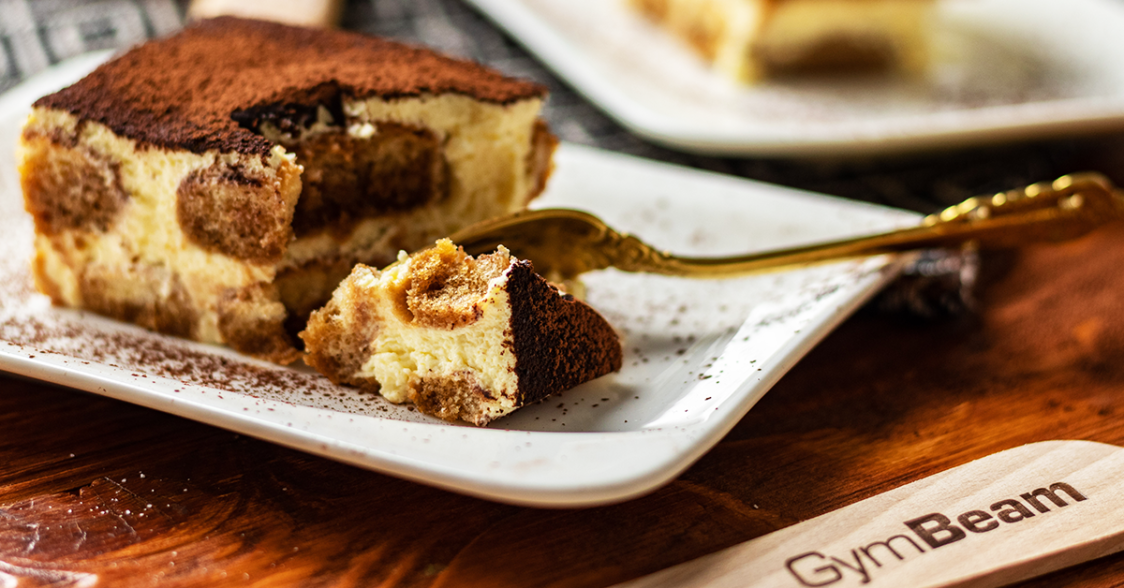
A great trick, for example, is whipping cottage cheese, protein or both into the finished pudding, which will make it a protein-rich snack that will actually fill you up.
| Dairy Product | Nutritional Values |
|---|---|
30% Heavy Cream | Energy value 291 kcal, protein 2 g, carbohydrates 3 g, fats 30 g |
| Sour cream 16% fat | Energy value 172 kcal, protein 3 g, carbohydrates 4 g, fats 16 g |
| Mascarpone Cheese | Energy value 386 kcal, protein 3 g, carbohydrates 5 g, fats 40 g |
| Fat Cottage Cheese | Energy value 141 kcal, protein 9 g, carbohydrates 4 g, fats 10 g |
| Low-fat Cottage Cheese | Energy value 68 kcal, protein 12 g, carbohydrates 4 g, fats 0.5 g |
Add vegetables or legumes to your desserts
Don’t worry, we’re not messing with you. Adding vegetables to a dessert increases its volume and reduces the caloric value, as the dough is “based” on a less caloric food. How about trying a carrot cake or porridge with zucchini? Legumes also have the same function in recipes, which also increase the protein content. Try, for example, fudgy bean brownies, for which you won’t even know that there are 400 g of beans in the dough.
Use less caloric flavourings
What do you usually add to pancakes, Nutella? How about trying a healthier protein option? In addition to preventing your teeth from aching due to excessive amount of sugar, you don’t have to blame yourself for eating a cheat meal. And if you’re trying to lose weight, zero syrup, which contains a negligible amount of calories, will be the perfect choice to top your pancakes.
- 30 g of Nutella has: 161 kcal, protein 2 g, carbohydrates 17 g, fat 9 g
- 30 g of Proteinela has: 144 kcal, protein 5 g, carbohydrates 13 g, fats 10 g
- 30 ml of calorie-free syrup has: 3 kcal, protein 0 g, carbohydrates 1 g, fat 0 g

What is the conclusion?
It doesn’t matter if you eat snacks regularly or just occasionally, in the evening or when you’re visiting friends. Keep in mind though, that there is a healthy version of virtually every meal, so it’s not a bad idea to choose what’s best for your body. However, no one is perfect, so you don’t have to feel remorse when you occasionally munch on something that isn’t the healthiest. Likewise, it’s not necessary to avoid all the goodies that are part of a buffet at a celebration. However, it’s important to know that even an ordinary canapé has calories, and to take this into account in your total intake. Otherwise, it can easily happen that if you treat yourself like this every week, you gain weight. This can happen despite the fact that you are in a caloric deficit from Monday to Friday.
You should take a similar approach, if you are a parent, with the snacks you are preparing for your children. It’s great when even the children know that an apple is more nutritious than a bar of chocolate, but on the other hand, it doesn’t make sense to restrict them from occasional sweets. As we all know, forbidden fruit tastes the sweetest, so by banning unhealthy snacks, you would induce an even greater desire for eating sweets or chips.
Are you a member of the snack team? If so, share with us your favourite snack tips, so that others don’t rely on everyday boredom in the form of a cheese on toast.
[1] CEP – https://www.fns.usda.gov/
[2] Režim jídla – https://www.stob.cz/cs/rezim-jidla
[3] FoodData Central – https://fdc.nal.usda.gov/fdc-app.html#/food-details/170273/nutrients
[4] Taubert a kol. – Effects of low habitual cocoa intake on blood pressure and bioactive nitric oxide: a randomized controlled trial – https://pubmed.ncbi.nlm.nih.gov/17609490/
[5] Jamshed a kol. – Dietary Almonds Increase Serum HDL Cholesterol in Coronary Artery Disease Patients in a Randomized Controlled Trial – https://pubmed.ncbi.nlm.nih.gov/26269239/
[6] Casas a kol. – The effects of the mediterranean diet on biomarkers of vascular wall inflammation and plaque vulnerability in subjects with high risk for cardiovascular disease. A randomized trial – https://pubmed.ncbi.nlm.nih.gov/24925270/
[7] Ehrenbergerová, Gajdošová – Cesta k opravdovému jídlu – ISBN: 978-80-270-6298-0
[8] Ralf Jäger a kol. – International Society of Sports Nutrition Position Stand: Protein and exercise. – https://doi.org/10.1186/s12970-017-0177-8
[9] Sacks a kol – Comparison of Weight-Loss Diets with Different Compositions of Fat, Protein, and Carbohydrates – https://www.ncbi.nlm.nih.gov/pmc/articles/PMC2763382/


Add a comment